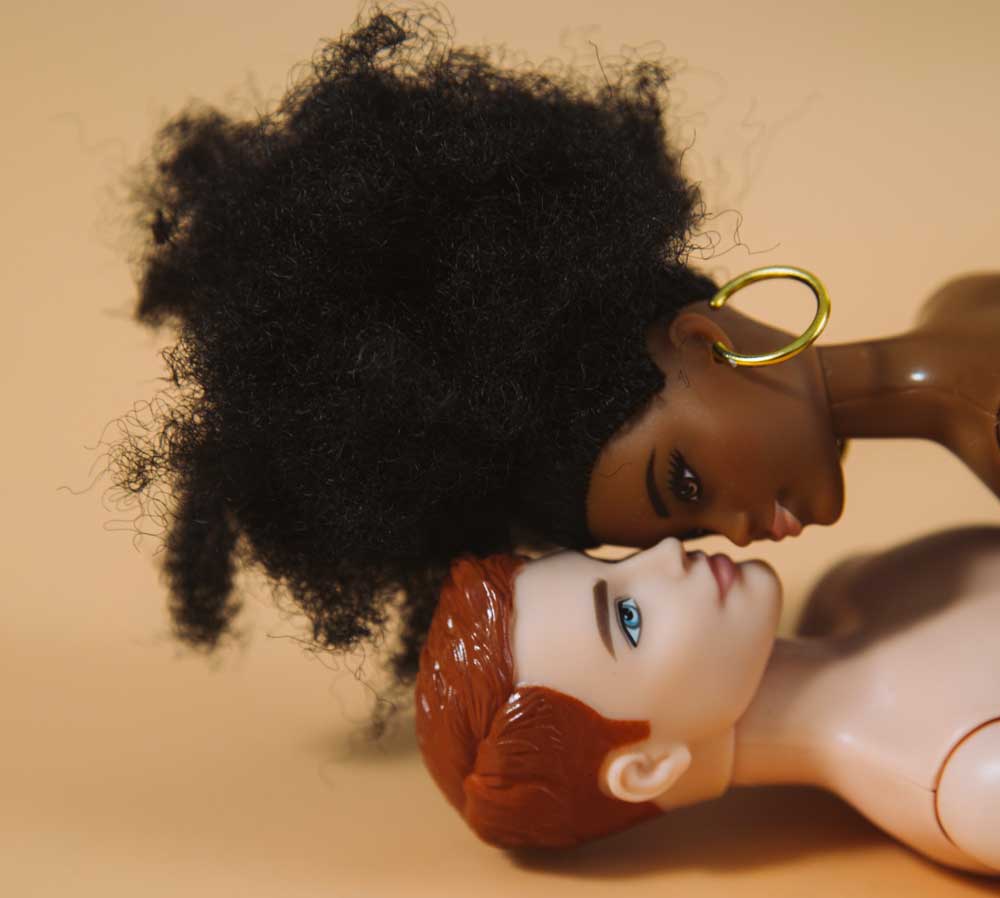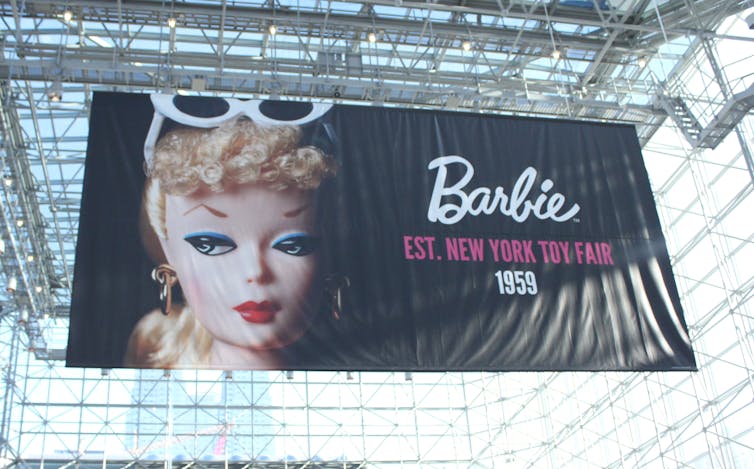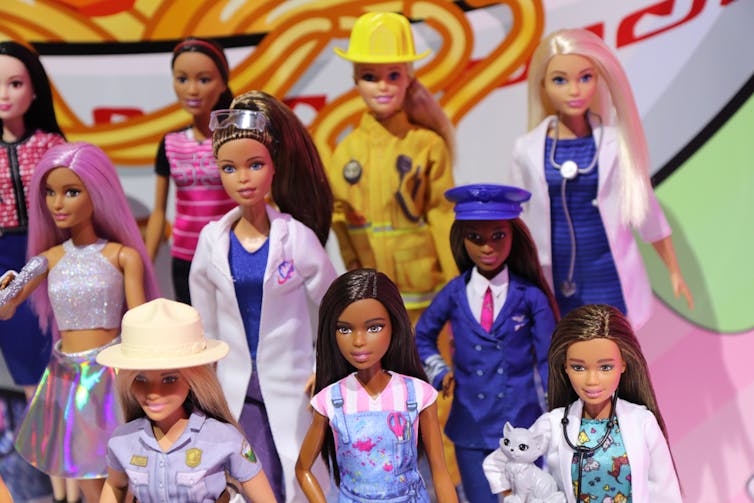
By Sameer Hosany
Rejected by the toy industry at first, Barbie is now one of America’s most trusted brands. “She” – the 11.5 inch blonde doll, but also her brand persona – generated worldwide sales of around US$1.5 billion (£1.3 billion) in 2022, and has a brand value of US$590 million.
Barbie debuted on March 9 1959 at the New York International Toy Fair as Barbie Teenage Fashion Model. Sixty-four years later, the doll continues to be the subject of cultural, sociological and psychological interest. By creating an iconic brand with special meaning for fans of all ages (Barbie is marketed to children aged three and older), toy company Mattel has successfully extended the lifecycle of the Barbie brand for well over half a century.
Barbie is also a polarising figure. The brand embodies the notion of a “double bind”, celebrated as an inspirational role model while at the same time blamed for creating unrealistic expectations of women, particularly when it comes to how they should look.
But while most toys remain popular for only two or three years, Barbie’s long-term success reflects Mattel’s responsiveness and adaptability to the changing cultural and political discourse in society and around this doll. So how has the company done it?
A Barbie girl, in a Barbie world
Research shows there are many ways to build and sustain brand characters, but Mattel has used a “multiply” strategy for Barbie. This has involved introducing other characters that play supporting roles in Barbie’s “world”.
Over the years, these supporting acts were introduced to portray Barbie’s relationship with friends and family. First there was Ken (1961), Barbie’s boyfriend, then her younger sister Skipper (1964), followed by friends including Midge (1963) and Christie (1968), the first black Barbie character.
The storylines and individual characteristics of these additional characters connect to Barbie’s persona and increase brand visibility. Mattel has also used storytelling tactics such as announcing that Barbie and Ken had officially broken up on Valentine’s Day in 2004 (they got back together in 2011). Such stories resonate with fans’ emotions, sustaining interest in the brand.
These tactics typically work for a while, but how has Mattel sustained true brand longevity for this long? There are many strategies designed to revitalise mature brands. Mattel successfully extended Barbie’s brand to capture new audiences, drive growth and expand into new types of products beyond dolls.
This is a risky endeavour if the brand is stretched too far. But Barbie’s brand has been successfully extended into other profitable categories such as clothes, accessories, cosmetics and entertainment (music, movies and games). And now, after several computer-animated, direct-to-video and streaming television films, Barbie’s first big budget, live action movie will be released in cinemas in July 2023.
Early reports suggest the movie – helmed by Oscar-nominee Greta Gerwig, who also directed Little Women (2019) and Lady Bird (2017) – is likely to be rated PG-13. This is not the “universal” rating you might expect for a film about a popular toy. It hints at another strand of Mattel’s successful Barbie branding strategy: nostalgia.
Life in plastic, it’s fantastic
Alongside ongoing efforts to appeal to young girls, Mattel also deliberately targets older consumers. Specific objects – not just toys but clothes, food such as sweets, or even items like vinyl records – can give a physical form to a set of attitudes, relationships and circumstances for people. This evokes a powerful sense of the past.
This kind of nostalgia generates trust and positive attitudes towards a brand, influencing consumer preferences when it comes to choosing between toys.
In addition to the upcoming film, Mattel has attempted to capitalise on the nostalgia Barbie evokes in other ways. It sells more sophisticated designer and limited edition lines of collectible dolls aimed at adult fans, for example. These items are typically sold in speciality or boutique stores, and carry higher price tags than the average doll.

Sean P. Aune/Shutterstock
Criticism of Barbie
As Barbie’s brand has expanded and evolved, the doll has also encountered criticism. Over the years, Barbie went through many transformations to look more confident, and was marketed as having many life options, particularly when it comes to work. There are now Barbie dolls representing more than 200 careers – from astronaut, surgeon, paratrooper, game developer, architect and entrepreneur to film director and even US president.
But critics have argued that these career dolls are a “misfire attempt at inspiring girls”. This negative perception of the brand’s moral vision is linked to the notion that Barbie is rooted in an ideal of femininity that still characterises women by their physical appearance.
Barbie has been accused of promoting unrealistic body standards, stereotyping and objectification of women, as well as having a negative influence on girls’ self-esteem and body image.

Sean P. Aune/Shutterstock
So, faced with declining sales and competition from smaller brands offering dolls with more realistic body types (such as Lottie and Lammily), Mattel launched “Project Dawn” in 2016. This included the launch of Fashionistas, a line of Barbie dolls with different body types (curvy, petite and tall) and abilities, skin tones and eye colours, as well as hairstyles and outfits.
But research suggested that young girls aged between three and ten prefered the original tall and petite dolls. They were negative about “curvy” Barbie, and this doll also received intense public scrutiny.
In 2017, Mattel took another significant step by introducing ethnically and racially diverse dolls of different nationalities, including the first hijab-wearing Barbie doll. However, this approach prompted criticism that Mattel was treating race and ethnic differences as “collectible”, and commodifying culture.
Despite this, Barbie continues to be a toy that many children play with. The longevity and iconic status of the doll is a tribute to Mattel’s astute marketing and reinvention efforts. These have helped the brand remain relevant even now, 64 years after it was launched.
![]()
Sameer Hosany is Professor of Marketing at Royal Holloway University of London.




























Pogo says
@Sameer Hosany
Sameer Hosany is Professor of Marketing at Royal Holloway University of London.
I buy that.
Is a flower an advertisement?
Leila says
Do we have drag queen Barbies? Seems to be ok with many. I just watched a commercial honoring women on NCIS. One of the scenes was a young woman sitting on a toilet with a bloody sanitary napkin between her knees. The sponsor was Content for Change MTV.
And I thought I had seen everything. It seems we now have no control over any of this.
Pierre Tristam says
You have too much control on what you shouldn’t touch—you being government, you being the Florida and so many other legislatures now copycatting the ALEC bill terrorizing drag shows, you being self-righteous opportunists using these performance artists to score your puerile ideological points with your perverted constituents who seem to have nothing better to do than to hound entertainers and spectators who are doing no one any harm. Of course we should have drag Barbie. Not that her plasticity has not been sexually fluid from day one. Mattel just won’t admit it. And so what if we do? If you take your children to church, you should have no problem taking them to a drag show. Same fantasies, different wardrobes, though I find drag shows less boring and more honest, not to mention spiritually more fulfilling.
Leila says
Puerile idealism? We should give each family the CHOICE. Nobody has the right to force their beliefs on anyone else. Agreed?
Freedom is about CHOICES. Have we forgotten that? Good grief.
Pierre Tristam says
That’s puerile ideology. But again: who’s forcing anything on you? Where’s the “choice” in bans of expression no one is forcing you to patronize? How are you giving these performers and their audiences a choice when you want them banned?
ralph6 says
Please define further your concepts of puerile ideology. I’d be interested in it.
The idea of drag shows is exactly as you state “no one is forcing you to patronize”. Except when they are perhaps part of a school class or a library event. If minors are involved the parents should know in advance and have the ability to opt out their kids with no repercussions.
There is a push-pull these days between agendas of schools and the agendas of parents. For many generations those agendas were pretty much the same. Not so much any longer. I come down on the side of the parents. You, Mr. Tristam seem to come down on the side of the teachers/administrators/unions — groups that are on record as not putting the interests of students and education first, rather putting first the interests of their members and their members’ agendas.
Leila says
Pierre, I have nothing against drag queens, but I definitely share Ralph’s feelings. Freedom is the right to choose, to be. I have the right to my feelings and you have the right to yours.
These entertainers do already have an audience, an adult audience, and have had for decades. It was not young children until recently. I didn’t say I wanted them banned. I said the wanted the option of choice to be exercised.
Pierre Tristam says
Leila, I certainly would not object to you preferring to stay out of drag shows, or keeping your children out of them. But would you object to my taking my children to a drag show? (Well, they’re grown now and leading their own kind of drag shows but you get my point: let’s assume I still had underage children. Would you object?)
Laurel says
Pierre, Leila and Ralph: Since I’m reminiscing here, I don’t think I would have minded drag queens at all as a kid. I know that they would not have changed my identity, or indoctrinated me in any way. My problem was with clowns. The only clowns I liked were Red Skelton, Danny Kaye and Emmet Kelly. The rest were a resounding NO! Stephen King got that. Also, I remember my mom asking me, when I was a tyke and we were visiting Manhattan, if I would like to sit on Santa’s lap. OH NO! There was something wrong if he was just in the last store we were in, and now here. Uh-uh! No, no, no.
Leila says
Nope. As I said, drag shows have been very popular in this country for decades, as ADULT shows because these shows are sexually titillating. Why do kids need to be exposed to that? I believe parents must be given the choice to do what they think is right for their kids. Everyone is pushing these kids to sex, sex and more sex. Why can’t they be kids until these things are more age appropriate? Parents need to be allowed to make these decisions.
Pierre Tristam says
Well then, we agree! parents need to be allowed to make those decisions, not government, right? You of the small government religion. But Leila, I think you’re misunderstanding drag shows. They’re only incidentally about sex, if that for many of them. Anyone getting horny at any of these things is barking up the wrong leg. To go to a drag show for the sex is like going to the opera for the plot. It’s hilarious. But it’s not the point.
Robert Joseph Fortier says
What IS the point? Should there be an age limit? And what is the purpose?
Laurel says
There is no more “reply” link below, but forgive me, I just have to:
When I read that drag queen shows are “sexually titillating,” I laughed so hard I started coughing! I am sorry, Leila, but sexually titillating is about the last thing I think of when watching Ru Paul’s Drag Race. Believe me, kids don’t see it that way either.
“Barking up the wrong leg” was pretty damned funny too!
Geezer says
As a boy growing up in the sixties, I owned great toys. Let’s see now: I had Johnny Lightning, Hot Wheels and my favorite of all,
GI Joe and most of his adventure sets. I decided that GI Joe needed a girlfriend, so I got him a Barbie, and hijacked Ken’s car too from a girlfriend. I proposed marriage to all the girls I loved for a week. I’d get free engagement rings from Cracker Jack boxes…
I scoffed at Action Jackson and the other pretenders that came along to bite off of GI joe—what nerve…
Catholic school and my sadistic teacher nuns were the only detractors from an idyllic childhood in New York’s Little Italy.
Oh, Mulberry Street, I miss you… I miss the fancy Cadillacs that parked at the hydrants, never being ticketed.
Silly me, I was scared of UPS trucks—I thought that they brought draft notices.
Yeah, I cried when Lassie shows would end, when the whistled closing theme started…
I saw an episode recently and started to cry. Geez…
Anyway, Barbie changed with the times, thus became “timeless.” Great ideas endure.
Long live Barbie! It’s an iconic little girl’s toy and a mate for a boy’s action figure…
I must say though—those two dolls depicted above might need to get a room…
Laurel says
Geezer: I relate! Maybe adults take things a little too seriously. I got my Barbie at age #?* and soon followed with a Ken, and then a Midge. Got some cool clothes, rattan furniture and a kitchen with a rotisserie oven and faucets that worked. Still got it all! Unfortunately, I cut Barbie’s black and white striped one piece into a bikini. Also cut her hair to find out she was bald under that ponytail. Then, I got a skate board and forgot all the other stuff. That lead to roller skates, which led to precision skates, which led to winning every race that I got in. I tried to race the boys but the adults wouldn’t let me.
So I didn’t take all the Barbie drama into consideration at all. However, as an adult, I knew a woman who did. She did her hair exactly like the blonde Barbie, and worked hard at being skinny and tall. Too bad.
Geezer says
I failed to say that I was a serial toy-breaker.
GI Joe’s limbs were attached at the time by elastic cord
in his torso, so I’d rotate his arms (wound them up) and watch as he helicoptered his arms in amazement.
I used to stage car accidents with my toy cars.
My Tonka trucks had a pint-sized aggressive driver for an owner.
You were a fun kid from what I’m gleaning here.
Had I known you way back then, you’d have gotten a Cracker Jack ring from me. That’s for sure… :-)
Laurel says
Geezer: I did get a Cracker Jack ring from a boy, and promptly ran over it with my bicycle. He cried. I feel bad to this day! So you’ve been spared.
Yeah, I used to take things apart to see how they worked. Built my first skateboard out of a piece of wood and a pair of those God awful, metal roller skates that would not stay on your shoes. Then, got the real thing. There’s a pretty, white church on Federal Highway, next to Tarpon River in Ft. Lauderdale. It’s sidewalk slopes down dramatically to a large blacktopped parking lot, wonderfully available six days a week! I cannot tell you how many times I went zooming down that slope on my skateboard, sometimes on my belly. No pads, no helmets, still lived.
My favorite toy company was Whamo! They had the best stuff.